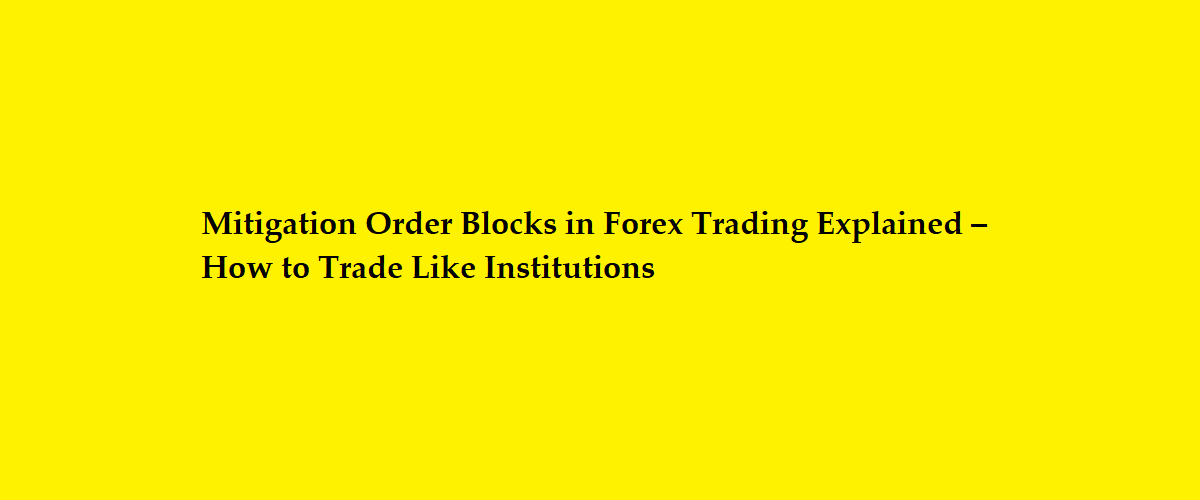Have you ever noticed how price often reverses at certain levels, only to continue its original trend shortly after? These mysterious zones are called mitigation order blocks (MOBs) – key areas where banks and institutional traders enter the market.
Unlike regular support/resistance levels, MOBs represent:
✅ Price zones where large orders were previously executed
✅ Areas where institutions “mitigate” their risk
✅ High-probability reversal points in trending markets
In this guide, you’ll discover:
✔ What exactly mitigation order blocks are
✔ How to spot them on your charts
✔ The best trading strategies using MOBs
✔ Top tools to identify these zones automatically
What is a Mitigation Order Block in Forex Trading?
A mitigation order block (MOB) is a specific price zone where institutional traders:
- Entered positions during a strong trend
- Left unfilled orders that still need execution
- Return to “mitigate” risk by closing positions
These blocks form when price makes an impulsive move, then pulls back to a consolidation area before continuing the trend.
Key Characteristics of MOBs:
🔹 Appear as small consolidation zones in trends
🔹 Precede strong impulsive moves
🔹 Act as magnet zones for price returns
🔹 Often align with Fibonacci levels (61.8%-79%)
How to Identify Mitigation Order Blocks (Step-by-Step)
Step 1: Find a Strong Impulsive Move
Look for a powerful candlestick that breaks structure (e.g., a large bullish engulfing bar).
Step 2: Locate the Consolidation Before the Move
The MOB forms at the base of this impulse – typically 1-5 candles of sideways price action.
Step 3: Mark the High/Low of the Block
- Bullish MOB: Low of the consolidation
- Bearish MOB: High of the consolidation
Step 4: Wait for Price to Return
Institutions often re-test these blocks before continuing the trend.
Top 3 Mitigation Order Block Trading Strategies
1. MOB Retest Strategy
- Entry: Price returns to MOB + bullish/bearish reversal pattern
- Stop Loss: Beyond the opposite side of the block
- Take Profit: Previous swing high/low
2. MOB with Fair Value Gap (FVG) Confluence
- Entry: MOB aligns with an unfilled FVG
- Confirmation: Strong rejection candle
- Target: Next liquidity zone
3. MOB Breakout Strategy
- Entry: Price breaks through MOB with volume
- Stop: Other side of the block
- Target: Measured move of the impulse
Best Tools to Find Mitigation Order Blocks
| Tool | Best For | Price |
|---|---|---|
| TradingView | Manual MOB drawing | Free/$ |
| MT4/MT5 MOB Indicator | Automatic detection | Free/$ |
| Price Action Toolkit | MOB + FVG scanning | $97+ |
| Order Flow Analytics | Institutional-level analysis | $$$ |
5 Critical Rules for Trading MOBs Successfully
- Only trade MOBs in the direction of the trend
- Wait for price confirmation (pin bar, engulfing)
- Combine with liquidity zones for higher probability
- Avoid trading MOBs during news events
- Always use proper risk management (1-2% per trade)
FAQs About Mitigation Order Blocks
1. Are MOBs the same as regular order blocks?
No – MOBs specifically form from unfilled institutional orders during trends.
2. Which timeframe is best for MOB trading?
4H and daily charts work best, but 1H can be used for entries.
3. How often do MOBs work?
About 65-75% success rate when combined with other confluences.
4. Can I use MOBs for scalping?
Yes, but stick to 15M+ timeframes for reliability.
5. Do MOBs work in crypto markets?
Yes, especially in BTC/USD and ETH/USD pairs.
